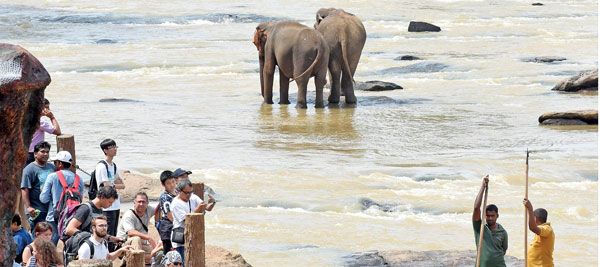02 Nov 2016 - {{hitsCtrl.values.hits}}

The Sri Lankan government has set a tourist arrival target of 2.2 million for this year. Despite the  lower arrival rates experienced recently, Sri Lanka Tourism Development Authority (SLTDA) and Sri Lanka Tourism Promotions Bureau (SLTPB) Chairman Paddy Withana, as well as Tourism Development, Land and Christian Affairs Minister John Amaratunga have been making the rounds lately, expressing that they are highly confident of achieving the target, given the advance bookings seen for the final calendar quarter of the year. However, simply put, can the current room supply in the country accommodate the remaining number of tourists needed to reach this target in the final calendar year?
lower arrival rates experienced recently, Sri Lanka Tourism Development Authority (SLTDA) and Sri Lanka Tourism Promotions Bureau (SLTPB) Chairman Paddy Withana, as well as Tourism Development, Land and Christian Affairs Minister John Amaratunga have been making the rounds lately, expressing that they are highly confident of achieving the target, given the advance bookings seen for the final calendar quarter of the year. However, simply put, can the current room supply in the country accommodate the remaining number of tourists needed to reach this target in the final calendar year?
The crunch
Calculating the number of tourists a given number of rooms can accommodate or the number of rooms required to achieve a certain tourist arrivals target is quite simple.
The number of tourists is calculated by multiplying the number of rooms in supply with the number of days in the period under discussion, number of tourists that stay in a room and average occupancy levels of a hotel, divided by the average duration of stay.
Two of these variables are readily available. The number of days for the three months from October to December (4Q16) is 92, while the number of tourists staying in a room is set at an industry standard of 1.8.
In terms of the room supply, since new properties are being added quite frequently, though at a slower pace this year, according to the Central Bank statistics, Mirror Business contacted the authorities to get an update on the picture. According to SLTDA Director Chandana Wijeratne, as of last week, there were 32,063 rooms in the formal sector, including hotels and supplementary accommodation. This number had been 31,168 in June. The addition of 500-room RIU Ahungalla Resort, which is a joint venture between the Aitken Spence group and multinational TUI Group, was the main reason for the boost.
While Wijeratne was not able to give an estimate for the informal sector, which has a near quarter of the accommodation market share, SLTDA Director General Malraj Kiriella in June had said that there were approximately 4,000 rooms in the informal sector, placing the total rooms in the country at present at just above 36,000.
Further, in the case of occupancy rates, SLTDA Statistics and International Relations Department Junior Manager Aruna Prasanjeewa—after obtaining permission from Kiriella, due to the standing orders in the SLTDA to repress the disclosure of information to the media—told Mirror Business that the occupancy rate for the first nine months of 2016 was 74.42 percent in the hotel sector.
The past data shows the occupancy rates in the registered, supplementary accommodation, which accounts for a quarter of the accommodation market share, to be much lower and in unregistered accommodation, which accounts for another quarter of the market share, to be much higher, though it is quite difficult to extract accurate data on the supplementary and informal sectors.
Prasanjeewa noted that the duration of stay for the past nine months was provisionally calculated to be 10.1 days.
The start of the peak season in the latter part of December—since most hotel chains such as Aitken Spence and Cinnamon have historically promoted deals to locals until as late as Christmas day—do give both the occupancy and duration of stay figures a boost, while October and November witness average occupancy.
For example, 4Q15 saw an occupancy rate of 75.87, helped by a December occupancy rate of 82.8 percent, as against an annual occupancy rate of 74.5 percent, according to the SLTDA data. The 4Q14 occupancy rates increase to 77.87, compared to an annual occupancy rate of 74.3 percent.
According to Prasanjeewa, even the average duration of stay increases slightly during the final quarter of the year due to increased arrivals of Europeans, who stay for longer to avoid the winter. This is compared to tourists from India and China, who stay for around six to eight days and are the largest markets of Sri Lanka. However, there may only be a limited impact of the increase seen in the last half of December, on the entire quarter.
However, many tour and hotel companies are corroborating the claims made by Withana and Amaratunga, saying that bookings for the final quarter of this year are better than the last, which could make the occupancy for the three months this year at least better than the 75.87 percent observed in 2015.
A few scenarios
Under the first hypothetical scenario, taking into consideration a simple weighted moving average for the occupancy rates of final quarters over the past five years, the occupancy for 4Q16 would be 77.3 percent. If further, an assumption is made that the duration of stay increases to 10.5 days in 4Q16, the number of tourists that can be accommodated would be 438,887.
Higher durations of stay—which the country should be striving to achieve—convert to more rooms required for tourists and vice versa.
Under a more unlikely scenario of an extremely bullish 85 percent occupancy with a 10.5-day duration of stay, the industry would only be able to support 482,605 tourists.
Given that 1.51 million tourists had arrived in Sri Lanka in the first nine months of the year, in the first scenario, the country’s tourism industry could only accommodate 1.95 million tourists, while under the second scenario, 1.99 tourists could be accommodated.
Even in the unlikely scenario of 100 percent occupancy, 567,771 tourists could be accommodated during the quarter, leading to 2.07 million tourists being accommodated through the industry during 2016.
VFR effect
However, in reality, more tourists could arrive in Sri Lanka than could be accommodated through the tourist industry. This is due to the VFR (visiting friends and relatives) tourists, who make up a quarter of the tourist arrivals to Sri Lanka. A majority of these tourists are either Sri Lankan expatriates or their descendants and therefore, a sizable portion of these tourists in turn tend to stay in their family homes or with their friends.
However, these VFR tourists also display many common characteristics of other leisure tourists by visiting many destinations within Sri Lanka and staying at hotels. Even so, to get a clear picture of this segment is difficult, since their local family or friends may have booked the accommodation on their behalf or in the case of dual citizens, may have used their own National ID during hotel bookings.
Perhaps some research has to be done in this area to determine how many VFR tourists stay in hotels as their primary lodging and for how long and how many stay in hotels as a smaller part of their holiday and the SLTDA could perhaps publish the breakdown of the purpose of travel over the 12 months of the year to determine VFR seasonality.
If 2.2 million tourists do arrive in Sri Lanka this year, approximately 550,000 tourists may be arriving to visit their friends and relatives and for 691,595 tourists the country needs to attract in 4Q16 to reach the target, 172,898 would be VFR tourists.
Therefore, even if none of the VFR tourists stay in tourism accommodation—which is unlikely—the industry has to support 518,697 tourists during the final quarter, which is still a massive gap from the 443,429 tourists the industry could accommodate in the first scenario.
In fact, to accommodate 518,697 tourists, the country would need 42,546 rooms, around 6,000 more that it currently has.
Reality of tourist arrivals
Therefore, it is quite unlikely that Sri Lanka will achieve the 2.2 million arrival target for this year, simply because there is not enough accommodation to house them. It appears that there may be a disconnect between the dreams of the government and the reality of the situation. A minute portion of the public and private sector individuals have admitted in the recent past that there are doubts about reaching the target.
It was also interesting to note that both Withana and Amaratunga had not made any mention of tourist arrivals at the Tourist Hotels’ Association of Sri Lanka Annual General Meeting held last week, though these numbers are usually the first words out of their mouths when addressing public forums and the media.
This is likely to become the second year in a row that Sri Lanka has not been able to achieve its targets and both instances after the regime change—notwithstanding the change of arrivals calculation methodology in 2013—which some might use to create political mileage. However, the stark reality is that Sri Lanka’s arrivals growth has been in decline since 2011 and hoping for a bigger growth without proper marketing is not logical, unless all the stars align in Sri Lanka’s favour.
A Rs.800 million marketing campaign is set to take off early next year after numerous delays, though how much of an impact it can have to increase growth levels remains in question, given that competing countries spend billions in their marketing efforts and many have already taken great steps towards filling the shoes of some of the more popular destinations that are on the decline due to terrorism threats.
Further, Withana, fresh from the failure of not reaching the 2015 target, had earlier this year set the new 2.2 million arrivals target for 2016 and a 4.5 million target for 2020 from the 2.5 million and 4.2 million targets, respectively set by the past regime, by stating that the former government had not done research to set realistic targets.
Clashing with sustainability?
Cutting through this rhetoric of generating increased arrivals is the rise of the sustainable tourism agenda, according to which, practicing sustainable tourism leads to higher revenue from an equal number of tourists, as they would be willing to pay more to enjoy their holiday with a clean conscience with regards to the effect they have on a destination’s society, culture, economy and environment.
According to celebrated tourism academic Michael C. Hall, politicians will always talk about increased income derived from tourism through increased arrivals, which is in direct opposition to sustainability. In Amaratunga’s defence, he has spoken of sustainability, and yet, without going into details on how he would accomplish this by involving the grassroots in tourism planning.
So far, Amaratunga has accommodated the whims and fancies of the powerful, mercantilist tourism lobbies, while local academics are pointing out that with the lack of proper planning to spread tourism across all regions, the more popular destinations are facing environmental and social decline.
The new government, just like how it reopened infrastructure projects it alleged had been started without proper environmental assessments, would likely be pushing for even more arrivals, given the state of its finances, while paying lip service to sustainability. This is being experienced by the people in Paanama first hand right now, where the government is refusing to return their land, which had been occupied by the military several years ago, which are now being used to construct hotels.
10 Jan 2025 18 minute ago
10 Jan 2025 23 minute ago
10 Jan 2025 2 hours ago
10 Jan 2025 2 hours ago
10 Jan 2025 2 hours ago